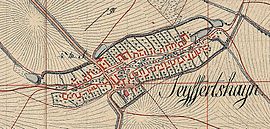Seifertshain
|
Seifertshain
Großpösna municipality
Coordinates: 51 ° 17 ′ 33 ″ N , 12 ° 31 ′ 1 ″ E
|
|
|---|---|
| Height : | 131 m |
| Residents : | 368 (Dec. 31, 2014) |
| Incorporation : | March 27, 1974 |
| Postal code : | 04463 |
| Area code : | 034297 |
Seifertshain is a village belonging to the municipality of Großpösna in the Leipzig district in Saxony . The place had 368 inhabitants in 2014.
geography
Seifertshain is about eleven kilometers southeast of Leipzig on a plain that slopes slightly to the northeast. It is the northernmost and smallest district of the municipality of Großpösna.
At a distance of about 300 meters from the south end extending A38 highway and the start at approximately the same distance from the Northeast end quarry gravel extraction Kleinpösna and Aue the Threne . Seifertshain is connected to local transport via the MDV bus route 75 Leipzig- Probstheida - Naunhof .
The neighboring towns of Seifertshain are Kleinpösna, Albrechtshain , Naunhof, Fuchshain , Großpösna, Liebertwolkwitz and Holzhausen, clockwise from the north . The farmsteads and houses are lined up on a road (county road K7927) about one kilometer long that runs in a south-east-north-west direction and is crossed by the K7901. The church and the former school are located on the latter. The place is surrounded by fields.
From its foundation, Seifertshain has been a street green village . In this type of settlement, the elongated, narrow village green, some of which contains small ponds, is lined by two paths along which the courtyards are located. All of this can still be seen on a map of Seifertshain from 1802. The present wide front gardens of the courtyards emerged from the field.
history
| Population development | |
| year | Residents |
| 1551 | 33 yards |
| 1764 | 34 yards |
| 1834 | 251 |
| 1871 | 319 |
| 1910 | 268 |
| 1925 | 338 |
| 1939 | 336 |
| 1946 | 399 |
| 1950 | 427 |
| 1964 | 310 |
| 2011 | 344 |
The name, first mentioned in 1295 as Syfardeshoyn , and the type of settlement indicate that Seifertshain was founded in the course of the German East Settlement . Since the church is not in the course of the street green, but on the cross street, the latter is probably to be seen as the founding core.
When the first church, mentioned in 1295, was built is not known. Documents about wood deliveries show that the church was rebuilt or expanded in 1560. A completely new building, which still exists today, took place in 1785–1787. Seifertshain was the mother church of the subsidiary churches Fuchshain and Kleinpösna, which are now all three together with Großpösna to form four sister parishes. The rectory dates from 1752. The beginnings of the Seifertshain school system go back to 1529. The sexton held the position of teacher, initially once a week. From 1580 reading and writing were taught alongside religion. The number of students fluctuated between 40 and 60 and was divided into two classes, which were taught in the morning and in the afternoon.
In the Thirty Years' War Seifertshain was not involved in combat operations. But the plague and looting brought great suffering to the population. In the Battle of the Nations near Leipzig , Seifertshain was on the edge of the battlefield, but it was also fought over and plundered. The Seifertshain residents fled to Albrechtshain and on to Brandis . Two farms burned down. The Austrian officer Alberti di Poja , who fell near Seifertshain, was buried in the cemetery, and numerous soldiers in a mass grave.
Manorial Seifertshain was the manor Pomßen assigned. Administratively it belonged to the Naunhof office , which was combined with the Electoral Saxon Hereditary Office Grimma in 1487 . From 1856 onwards the place belonged to the Brandis court office and from 1875 to the Amtshauptmannschaft Grimma until it came to the Leipzig-Land district in the Leipzig district in 1952 . Apart from fluctuations caused by the war, the number of inhabitants in Seifertshain has remained almost unchanged over the past 150 years, even after the building boom that began in the neighboring communities after 1990. In 1974 Seifertshain was incorporated into Großpösna.
In 1995 a medical and hospital museum was set up in the old school. It commemorates the care of the numerous wounded in the Battle of Nations in the buildings of the inn and parsonage that have been converted into hospitals, and the hospital barn that has been preserved.
Attractions
- The church from 1787
- The rectory, built in 1752
- The tombstone for Count Alberti di Poja, who died in the Battle of the Nations
- The hospital museum in the old village school
- The Paltrock windmill on the road to Kleinpösna
literature
- The Seifertshain Parish. In: Neue Sächsische Kirchengalerie, Die Ephorie Grimma links der Mulde. Strauch Verlag, Leipzig 1911, Sp. 705–823 ( digitized )
- Seyfertshayn . In: August Schumann : Complete State, Post and Newspaper Lexicon of Saxony. 11th volume. Schumann, Zwickau 1824, pp. 126–128.
- Cornelius Gurlitt : Seifertshain. In: Descriptive representation of the older architectural and art monuments of the Kingdom of Saxony. 20. Issue: Amtshauptmannschaft Grimma (2nd half) . CC Meinhold, Dresden 1898, p. 87.
Web links
- Seifertshain in the Digital Historical Directory of Saxony
- Seifertshain on the Großpösna website
- Unofficial page about Seifertshain
- Website of the hospital museum
Individual evidence
- ↑ Digital Historical Directory of Saxony , accessed on April 28, 2013
- ↑ grosspoesna.de
- ↑ Großpösna rectory
- ^ Karlheinz Blaschke , Uwe Ulrich Jäschke : Kursächsischer Ämteratlas. Leipzig 2009, ISBN 978-3-937386-14-0 ; P. 60 f.







